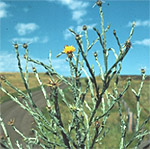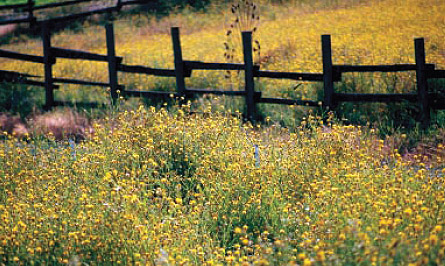Yellow Starthistle
 Centaurea solstitialis
Centaurea solstitialis
Overview
Long-lived winter annual that spreads by seed. It invades native plant communities, reducing biodiversity, and wildlife habitat & forage. It is replacing important forage vegetation and reducing rangeland values.
Ingestion by horses may result in a fatal nervous disorder known as "chewing disease." Metabolism of chemicals in yellow starthistle produces a toxin which causes death of nerve centers in the brain controlling normal eating & drinking. Only horses are affected and there is no cure.
Identification
Stems: Erect, branching, rough, up to 1 m tall, forming a bushy looking cluster. Entire plant is grayish to blue-green and covered with fine, white, cottony hairs.
Leaves: Lower leaves are deeply lobed, upper leaves have an entire margin and become smaller towards the top of the plant. Leaf bases extend down the stem forming a fringe.
Flowers: Small yellow flowers clustered in a head to resemble a single flower, solitary at ends of branches, sharp yellowish spines up to 2 cm long extend from below the flower head.
Seed: Seeds are tan with brown mottling and about 3 mm long. Both plumed and un-plumed seeds are produced.

Information and large photograph above courtesy of the Alberta Invasive Plant Council.
Resources
Yellow Starthistle ISCM Fact Sheet
2011 Rural Municipality Distribution Map
2010 Rural Municipality Distribution Map
Alberta Invasive Plant Council Fact Sheet
Â
Back to Terrestrial Invasive Species List
Â
© Copyright 2004-2025 - CMS Made Simple
This site is powered by CMS Made Simple version 1.4.1


